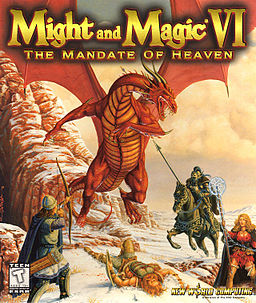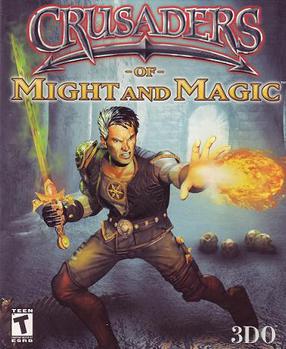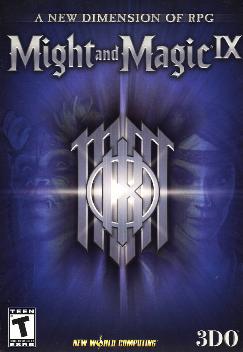
Might and Magic is a series of role-playing video games from New World Computing, which in 1996 became a subsidiary of The 3DO Company. The original Might and Magic series ended with the closure of the 3DO Company. The rights to the Might and Magic name were purchased for US$1.3 million by Ubisoft, who "rebooted" the franchise with a new series with no apparent connection to the previous continuity, starting with the games Heroes of Might and Magic V and Dark Messiah of Might and Magic.
Heroes of Might and Magic, known as Might & Magic Heroes since 2011, is a series of video games originally created and developed by Jon Van Caneghem through New World Computing.

In fantasy fiction, a lich is a type of undead creature.

King's Bounty is a turn-based fantasy video game designed by Jon Van Caneghem and published by New World Computing in 1990. The game follows the player's character, a hero of King Maximus, appointed with the job of retrieving the Sceptre of Order from the forces of chaos, led by Arech Dragonbreath. King's Bounty is notably considered the forerunner of the Heroes of Might and Magic series of games.

Heroes of Might and Magic III: The Restoration of Erathia is a turn-based strategy game developed by Jon Van Caneghem through New World Computing originally released for Microsoft Windows by The 3DO Company in 1999. Its ports to several computer and console systems followed in 1999–2000. It is the third installment of the Heroes of Might and Magic series.

Might and Magic VI: The Mandate of Heaven, commonly abbreviated to Might and Magic VI or simply MM6, is a role-playing video game developed by New World Computing and published by 3DO in 1998. It is the sixth installment in the Might and Magic series, the sequel to Might and Magic V: Darkside of Xeen and the first of the Might and Magic titles to take place on the same planet as Heroes of Might and Magic. It continues the storyline of Heroes of Might and Magic II, and takes place at the same time as Heroes of Might and Magic III in the series chronology. The game was compared favorably to its peers, role-playing video games such as The Elder Scrolls II: Daggerfall. Critics praised it for its non-linear, user-friendly premise, an interactive, detailed game world and a polished, bug-free initial release. A Limited Edition version of the game was also released, including a cloth map of Enroth, a strategy guide and the first five games of the series on CD-ROM. It was followed by three sequels, with Might and Magic VII: For Blood and Honor directly continuing the story arc.

Heroes of Might and Magic IV is a turn-based strategy game developed by Gus Smedstad through New World Computing and published by the 3DO Company for Microsoft Windows-based personal computers in 2002. A Macintosh port was subsequently developed by Contraband Entertainment and released by the 3DO Company. The fourth installment of the popular Heroes of Might and Magic franchise, it is the sequel to Heroes of Might and Magic III, and was the last to be developed by New World Computing.

Heroes of Might and Magic II: The Succession Wars is a turn-based strategy video game developed by Jon Van Caneghem through New World Computing and published in 1996 by the 3DO Company. The game is the second installment of the Heroes of Might and Magic series and is typically credited as the breakout game for the series. Heroes II was voted the sixth-best PC game of all time by PC Gamer in May 1997.

New World Computing, Inc. was an American video game developer and publisher founded in 1984 by Jon Van Caneghem, his wife, Michaela Van Caneghem, and Mark Caldwell. It was best known for its work on the Might and Magic role-playing video game series and its spin-offs, especially Heroes of Might and Magic. The company was purchased by and became a division of The 3DO Company on July 10, 1996 from NTN Communications, after NTN purchased New World Computing for $10 million in stock.

Jon Van Caneghem is an American video game director, designer and producer. He is best known for launching development studio New World Computing in 1983, making his design debut in 1986 with Might and Magic Book One: The Secret of the Inner Sanctum. During the company's 20-year lifespan, Van Caneghem was involved in the creation and direction of several franchises, including the Might and Magic role-playing series and the spin-off Heroes of Might and Magic and King's Bounty strategy series.

Might and Magic VII: For Blood and Honor is a role-playing game for Windows published in 1999 by 3DO and developed by New World Computing; it was re-released in 2011 on GOG.com. The game follows on from both the events of Heroes of Might and Magic III, and those of Might and Magic VI: The Mandate of Heaven. Players form a party of four characters who win a castle in a scavenger hunt and soon become embroiled in political events on the continent of Antagarich, on the world of Enroth, before eventually choosing one of two paths and working alongside a number of characters, whose storyline continues on from the events of Might and Magic III: Isles of Terra. The game, Might and Magic VIII: Day of the Destroyer is a sequel to Blood and Honor.

Might and Magic VIII: Day of the Destroyer is a role-playing video game developed for Microsoft Windows by New World Computing and released in 2000 by The 3DO Company. It is the eighth game in the Might and Magic series. The game received middling critical reviews, a first for the series, with several critics citing the game's length and its increasingly dated game engine, which had been left fundamentally unaltered since Might and Magic VI: The Mandate of Heaven in 1998. The game was later ported to PlayStation 2 in Japan and published by Imagineer on September 6, 2001.

Heroes of Might and Magic: A Strategic Quest is a turn-based strategy game developed and published by New World Computing in 1995 for DOS. A spin-off of New World Computing's Might and Magic series of role-playing video games, the success of Heroes of Might and Magic led to a number of sequels.

Crusaders of Might and Magic is a third-person action/RPG video game developed and published by 3DO's Austin, Texas studio (PlayStation) and Redwood Shores studio (PC). Different versions of the game were released for both Microsoft Windows and the PlayStation. The protagonist Drake was voiced by veteran voice actor Kevin Conroy.

David Mullich is an American game producer and designer best known for creating the cult classic 1980 adventure game The Prisoner, producing the 1995 adaptation I Have No Mouth, and I Must Scream, and developing many games in the Heroes of Might and Magic franchise. With a career spanning more than twenty-five years, Mullich worked not only for some of the first video game publishers, but went on to work for some of the biggest game companies of today.

Might and Magic IX is a role-playing video game, the last developed by New World Computing for Microsoft Windows and released in 2002 by The 3DO Company. It is the sequel to Might and Magic VIII: Day of the Destroyer. It is the first to feature a significant game engine overhaul since 1998's Might and Magic VI: The Mandate of Heaven. Powered by the Lithtech 1.5 engine, it was also the first game in the series to feature fully three-dimensional graphics. During production, it was known by the working title of Might and Magic IX: Writ of Fate, and it is usually referred to by that title by fans of the series.
Gregory Fulton is an American computer game designer best known for his work on the Heroes of Might and Magic series.

Heroes Chronicles is a series of turn-based strategy video games developed by Jon Van Caneghem through New World Computing and published by the 3DO Company. The series was intended to introduce a new audience, such as casual gamers, to the Heroes of Might and Magic series. As part of that strategy, each installment of Chronicles was released as a low-cost episode containing a relatively short single-player campaign, and the difficulty level of each game was kept low. All Chronicles games are based on a limited version of the Heroes of Might and Magic III game engine, although the ability to play scenario maps and multiplayer games is not included in any Chronicles title.

Heroes of Might and Magic III: The Shadow of Death is the second of two expansion packs for the turn-based strategy game Heroes of Might and Magic III. It was developed by New World Computing for Microsoft Windows and released by The 3DO Company in 2000. Shadow of Death is a standalone expansion pack that includes the original game.

















